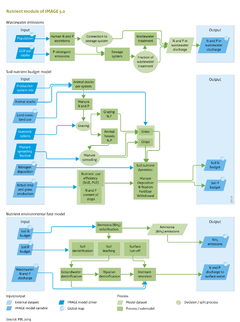Nutrients/Description: Difference between revisions
Jump to navigation
Jump to search
Oostenrijr (talk | contribs) m (Text replace - "N2 " to "N<sub>2</sub> ") |
Oostenrijr (talk | contribs) m (Text replace - "NH3" to "NH<sub>3</sub>") |
||
| Line 15: | Line 15: | ||
The soil N budget (N<sub>budget</sub>) is calculated as follows:{{FormulaAndTableTemplate|Formula2_N}} | The soil N budget (N<sub>budget</sub>) is calculated as follows:{{FormulaAndTableTemplate|Formula2_N}} | ||
The same approach is used for P, with input terms being animal manure and fertiliser. The soil nutrient budget does not include nutrient accumulation in soil organic matter for a positive budget (surplus), or nutrient depletion due to soil organic matter decomposition and mineralisation. With no accumulation, a surplus represents a potential loss to the environment. For N this includes | The same approach is used for P, with input terms being animal manure and fertiliser. The soil nutrient budget does not include nutrient accumulation in soil organic matter for a positive budget (surplus), or nutrient depletion due to soil organic matter decomposition and mineralisation. With no accumulation, a surplus represents a potential loss to the environment. For N this includes NH<sub>3</sub> volatilisation (see Component [[Emissions]]), denitrification, surface runoff and leaching. For P, this is surface runoff. | ||
For spatial allocation of the nutrient input to IMAGE grid cells, grass and the crop groups in IMAGE (temperate cereals, rice, maize, tropical cereals, pulses, roots and tubers, oil crops, other crops, energy crops) and grass are aggregated to five broad groups. These groups are grass, wetland rice, leguminous crops, other upland crops and energy crops for both mixed and pastoral production systems (see [[Livestock systems]]). | For spatial allocation of the nutrient input to IMAGE grid cells, grass and the crop groups in IMAGE (temperate cereals, rice, maize, tropical cereals, pulses, roots and tubers, oil crops, other crops, energy crops) and grass are aggregated to five broad groups. These groups are grass, wetland rice, leguminous crops, other upland crops and energy crops for both mixed and pastoral production systems (see [[Livestock systems]]). | ||
| Line 36: | Line 36: | ||
====Nutrient withdrawal==== | ====Nutrient withdrawal==== | ||
Withdrawal of N and P in harvested products is calculated from regional crop production in IMAGE and the N and P content for each crop, which is aggregated to the broad crop categories (wetland rice, leguminous crops, upland crops and energy crops). IMAGE also accounts for uptake by fodder crops. N withdrawal through grass consumption and harvest is assumed to amount to 60% of all N input (manure, fertiliser, deposition, N fixation), excluding | Withdrawal of N and P in harvested products is calculated from regional crop production in IMAGE and the N and P content for each crop, which is aggregated to the broad crop categories (wetland rice, leguminous crops, upland crops and energy crops). IMAGE also accounts for uptake by fodder crops. N withdrawal through grass consumption and harvest is assumed to amount to 60% of all N input (manure, fertiliser, deposition, N fixation), excluding NH<sub>3</sub> volatilisation. P withdrawal through grazing or grass cutting is calculated as a proportion of 87.5% of fertiliser and manure P input. The rest is assumed to be lost through surface runoff. In calculating spatially nutrient withdrawal, a procedure is used to downscale regional crop production data from IMAGE to country estimates for nutrient withdrawal based on distributions in 2005. | ||
===Nutrient environmental fate=== | ===Nutrient environmental fate=== | ||
Revision as of 10:39, 1 July 2014
Parts of Nutrients/Description
| Component is implemented in: |
| Components: |
| Related IMAGE components |
| Projects/Applications |
| Key publications |
| References |
